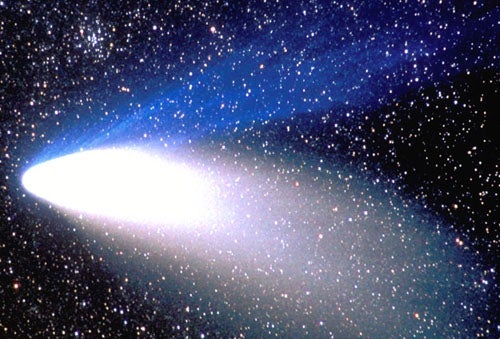If comets exist around other stars, astronomers should be able to see them directly, says an astronomer at the University of California in Los Angeles (UCLA). All they need to do is use the same observatories that promise to reveal Earth-size extrasolar planets.
Astronomers have discovered more than 100 planets around other stars, but all these worlds are either giant planets orbiting Sun-like stars or small planets orbiting a pulsar. The ultimate goal of planet hunters is the discovery of an Earth-size planet circling a Sun-like star, because such a world might harbor life. To find an analog to Earth, astronomers have proposed building space-based observatories like the Terrestrial Planet Finder and Darwin.
These observatories should see more than just Earth’s twin, says UCLA astronomer Michael Jura. “Any system which will be able to obtain direct images of an analog to the Earth also will be able to detect bright comets,” he writes in a paper to appear in The Astronomical Journal later this year.
Comets are much smaller than Earth, but as they approach the Sun, its radiation heats their surfaces and causes them to sprout two types of tails: dust and gas. A comet’s dust tail scatters much sunlight. In fact, Jura calculates, a bright comet observed from another planetary system would be at least as bright as Earth. For example, he says Comet Hale-Bopp, a great comet that passed Earth in 1997, actually outshone Earth. Any extraterrestrial astronomer able to see Earth also should have seen the comet.
On the other hand, Comet West, a great comet that passed Earth in 1976, might have escaped detection. Although Comet West also was bright, it passed so close to the Sun that seeing it would have been hard for an extraterrestrial observer.
The best stars for extrasolar comet hunters to examine are those somewhat brighter than the Sun, says Jura. The more luminous the star, the more starlight both a planet and a comet reflect. However, the comet gets an additional boost because as more radiation hits it, more of its ice vaporizes and more dust launches into space.
Jura calculates a comet like Hale-Bopp would fail to outshine an Earth analog around a star that had less than half the Sun’s luminosity. This luminosity corresponds to spectral type G8, the same spectral type as the nearby star Tau (τ) Ceti.
Only about 1 percent of the time would a comet as large as Hale-Bopp be visible around the Sun, Jura estimates. Thus, if other stars have comet clouds like the Sun’s, astronomers would need to observe about a hundred stars to see one extrasolar comet.
However, no one yet knows what percentage of stars have comets like the Sun’s. Some stars may have no comets. By discovering extrasolar comets, Jura says astronomers can estimate just how common comets are.










